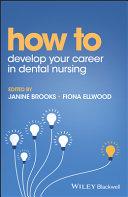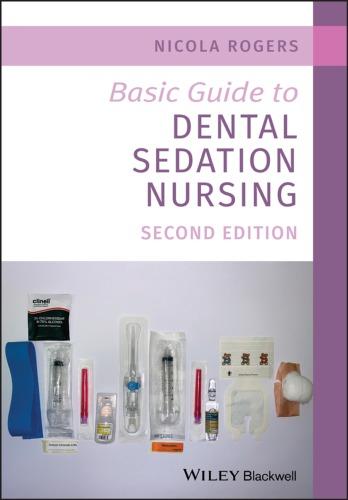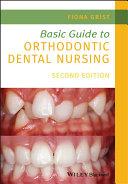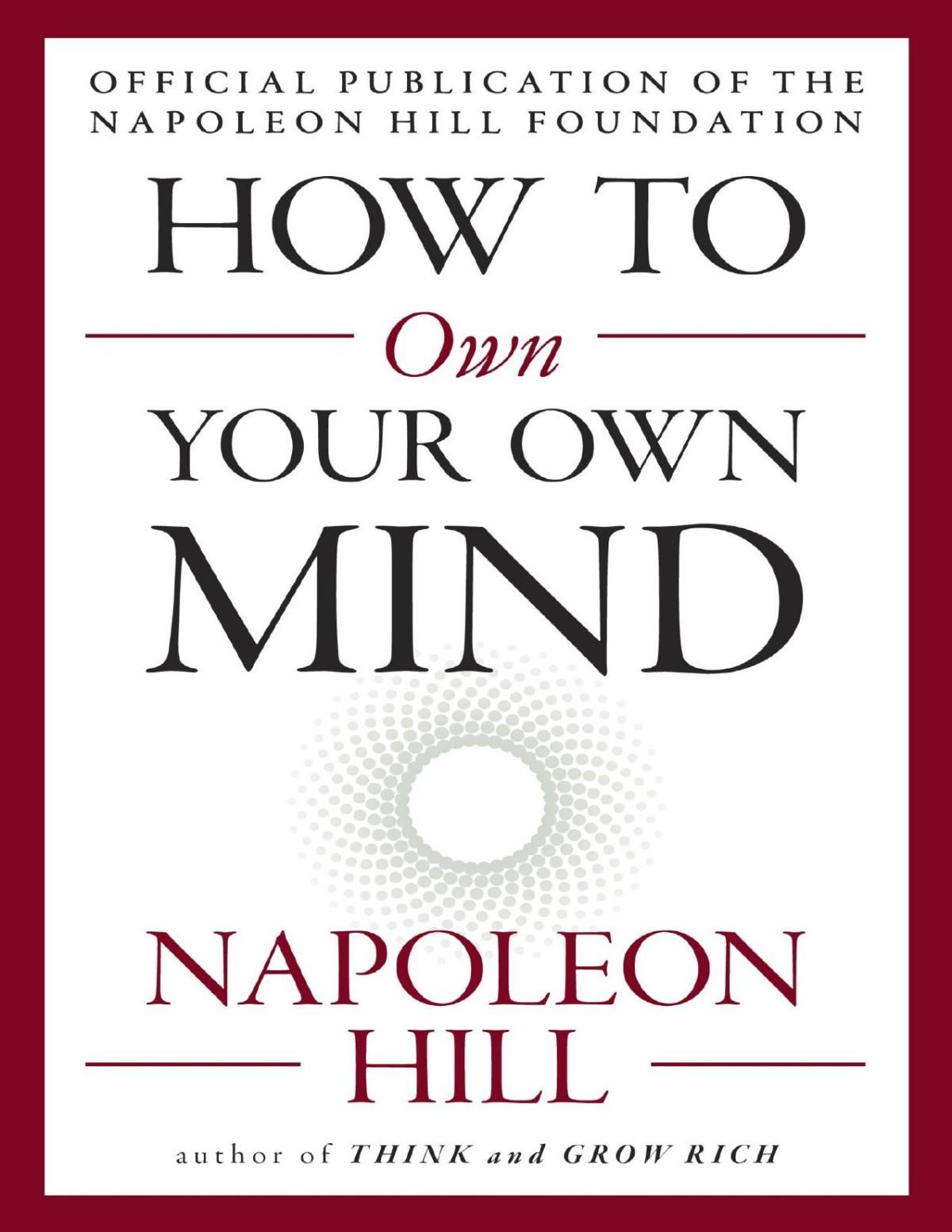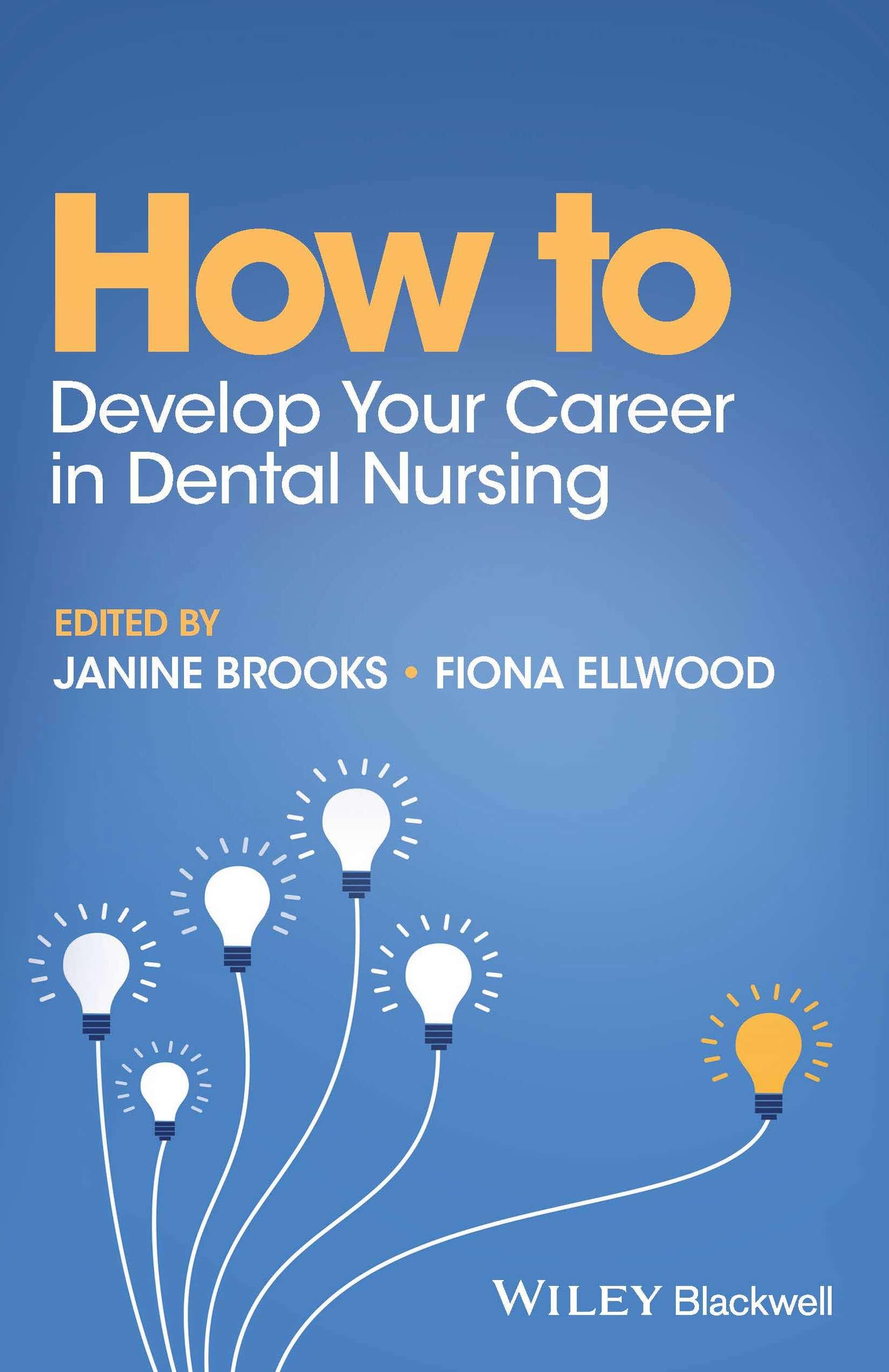How to Develop Your Career in Dental Nursing
Janine Brooks MBE, DMedEth, MSc, FFGDP(UK), MCDH, DDPHRCS, BDS, FAcadMEd
CEO of Dentalia Coaching and Training Consultancy, co-founder of Dental Mentors UK and registration assessment panellist for the General Dental Council
Fiona Ellwood BEM, MEd LM, PG Cert HF/E, PG Cert PH, PG Cert DMent, BA (Hons) Ed S, (Hon) FFGDP, former FDTF RCS (Ed), MAadMEd, NSCTS practitioner, mental health first aider
Specialist expert advisor at Bangor University, education associate and registration panel member for the General Dental Council
This edition first published 2023 © 2023 John Wiley & Sons Ltd
All rights reserved. No part of this publication may be reproduced, stored in a retrieval system, or transmitted, in any form or by any means, electronic, mechanical, photocopying, recording or otherwise, except as permitted by law. Advice on how to obtain permission to reuse material from this title is available at http://www.wiley.com/go/permissions.
The right of Janine Brooks and Fiona Ellwood to be identified as authors of the editorial material in this work has been asserted in accordance with law.
Registered Offices
John Wiley & Sons, Inc., 111 River Street, Hoboken, NJ 07030, USA
John Wiley & Sons Ltd, The Atrium, Southern Gate, Chichester, West Sussex, PO19 8SQ, UK
For details of our global editorial offices, customer services, and more information about Wiley products visit us at www.wiley.com.
Wiley also publishes its books in a variety of electronic formats and by print-on-demand. Some content that appears in standard print versions of this book may not be available in other formats.
Trademarks: Wiley and the Wiley logo are trademarks or registered trademarks of John Wiley & Sons, Inc. and/or its affiliates in the United States and other countries and may not be used without written permission. All other trademarks are the property of their respective owners. John Wiley & Sons, Inc. is not associated with any product or vendor mentioned in this book.
Limit of Liability/Disclaimer of Warranty
The contents of this work are intended to further general scientific research, understanding, and discussion only and are not intended and should not be relied upon as recommending or promoting scientific method, diagnosis, or treatment by physicians for any particular patient. In view of ongoing research, equipment modifications, changes in governmental regulations, and the constant flow of information relating to the use of medicines, equipment, and devices, the reader is urged to review and evaluate the information provided in the package insert or instructions for each medicine, equipment, or device for, among other things, any changes in the instructions or indication of usage and for added warnings and precautions. While the publisher and authors have used their best efforts in preparing this work, they make no representations or warranties with respect to the accuracy or completeness of the contents of this work and specifically disclaim all warranties, including without limitation any implied warranties of merchantability or fitness for a particular purpose. No warranty may be created or extended by sales representatives, written sales materials or promotional statements for this work. This work is sold with the understanding that the publisher is not engaged in rendering professional services. The advice and strategies contained herein may not be suitable for your situation. You should consult with a specialist where appropriate. The fact that an organization, website, or product is referred to in this work as a citation and/or potential source of further information does not mean that the publisher and authors endorse the information or services the organization, website, or product may provide or recommendations it may make. Further, readers should be aware that websites listed in this work may have changed or disappeared between when this work was written and when it is read. Neither the publisher nor authors shall be liable for any loss of profit or any other commercial damages, including but not limited to special, incidental, consequential, or other damages.
Library of Congress Cataloging-in-Publication Data applied for ISBN: 9781119861706; ePDF: 9781119861713; epub: 9781119861720; oBook: 9781119861737
Cover Design: Wiley
Cover Image: © Feodora/Adobe Stock Photos
Set in 10.5/13pt Minion by Straive, Pondicherry, India
‘. . .
We shall not cease from exploration And the end of all our exploring Will be to arrive where we started And know the place for the first time.’
T.S Eliot (1888–1965)
Dedication
To all those early dental nurses who paved the way for today. To all the dental nurses of today who are paving the way for the future of the profession. Be proud.
Contents
About the authors, xi
Foreword, xv
Preface, xvii
Acknowledgements, xxi
Chapter 1 Introduction, 1
Chapter 2 Early history of dental nursing, 8
The nineteenth century, 12
The twentieth century, 20
Role of the world wars, 30
Women in employment – twentieth and twenty-first centuries, 32
The twenty-first century, 34
Chapter 3 The rise of the profession, 44
North America, 46
New Zealand, 48
Canada, 49
United Kingdom, 50 Republic of Ireland, 54 Europe, 55 Australia, 56 Worldwide, 56
Chapter 4 Training and qualifications, 59
Professional registration and dental nurse qualifications, 60
Dental nursing qualifications, 61
Additional duties, 66
Impact of registration and education, 67
Continuing professional development (CPD), 70
Reflective practitioner, 73
Chapter 5 Career development, 77
Clear understanding of self, 80
Knowledge of the dental landscape, 80
Conditions of success, 80
Lead roles, 82
Other opportunities, 89
Examples of career pathways, 93
Shape of your career, 96
Developing a professional portfolio, 97
Curriculum vitae design, 98
Promoting yourself, 98
Chapter 6 The future, 101
The world outside dentistry, 102
The future of dentistry, 107
The profession of dental nursing, 109
Individual dental nurses, 110
Thoughts on future training, 113
The advanced dental nurse practitioner, 113
Twenty-first century skills, 113
Examples to build your working portfolio and progress your career, 117
Chapter 7 Discussion and conclusions, 121
Appendix 1 Timeline of important events in dentistry in the UK, 127
Index, 129
About the authors
Fiona Ellwood BEM
General Dental Council registrant and mental health wellness campaigner
MEd LM, PG Cert HF/E, PG Cert Public Health, PG Cert Mentoring in Dentistry, BA (Hons) Ed S, PG Cert Ed (PGCE), (Hon) FFGDP (UK), FDTF (RCS Ed) IAM and RSPH fellowships, NCSCT practitioner, doctoral student, trustee of Dentaid
Fiona is a member of the Executive Board and elected President 2019–22 of the Society of British Dental Nurses, leading on Education Governance and Quality Assurance with a special interest in public health matters. She is the Immediate Past Chair of the National Oral Health Promotion Group and is a key opinion leader and an advisor. She writes extensively for a number of journals. Fiona has been a dental nurse for 37 years, although she first entered the field 40 years ago. She speaks nationally and internationally on related topics. She is immensely proud to have been involved in the Scottish Dental Clinical Effectiveness Programme (SDCEP) research during the pandemic and many key stakeholder meetings.
Fiona is a trained and practising mentor and mental health first aider, with many years of experience. She has studied and been successful at Masters level and is a doctorate student. She is a subject expert at Bangor University, Wales, and part of the innovative work that is rethinking and redesigning dental education and training. Fiona is an external examiner in the Republic of Ireland and is a member of the Human Factors Advisory Board. She is co-chairing a four-nation mental health wellness framework for adoption in primary and secondary care, across all dental professional groups, having gained the support of chief dental officers and the Royal Colleges, as well as the regulators.
In 2019 Fiona was appointed to the Interim Education Advisors Board, RCS Edinburgh, and represents the Dental Dean on the One Voice work; she is also a regional ambassador for RCS Edinburgh. She was the first dental care professional to receive an honorary fellowship from the FGDP (UK) RCS England and one of the first to be awarded the fellowship of the Faculty of Dental Trainers, RCS Edinburgh. Fiona was also privileged to be appointed the (Hon) Vice President of the British Society of Dental Hygiene and Therapy (BSDHT). Fiona is a former President of the British Association of Dental Nurses and an examiner for the National Examining Board of Dental Nurses and the Oral Health Education Examining Board.
Fiona is an education associate for the GDC and a member of the Registration Panel; she has also advised for Quality and Qualifications Ireland (QQI) Republic of Ireland. She is a trustee at Dentaid and supports the Mouth Cancer Foundation on education matters. To this end, she has also been working on an implementation programme for sustainable oral health in Nepal via RCS Edinburgh. Fiona has been instrumental in setting up the Dental Professional Alliance, a group where all dental care professional presidents meet to discuss matters of interest and to work together when the need arises. She is also proud to have brought to fruition the ‘SafeSpace’ initiative for dental nurse students.
In June 2019 Fiona was awarded the British Empire Medal in the Queen’s Birthday Honours for her contribution to dentistry. On 12 March 2021, Fiona was very proud to co-announce the launch of the International Federation of Dental Assistants and Nurses in which she, on behalf of the Society of British Dental Nurses, has played an instrumental part.
In 2021 she was presented with an award from the NEBDN for her contribution to dental nurse education and spoke on advocacy for the British Fluoridation Society. Fiona is currently a co-investigator as part of an NIHR research project with Newcastle University.
Dr Janine Brooks MBE
DMed Eth, MSc, FFGDP(UK), MCDH, DDPH(RCS), BDS, FAcadMEd, CEO of Dentalia Coaching and Training Consultancy, Director of the Dental Coaching Academy, co-founder of Dental
Mentors UK, private coach and mentor (Remediation, Career and Personal Development), registration assessment panellist for the General Dental Council, trustee of the Dentists’ Health Support Trust, expert witness, trustee of the NHS Retirement Fellowship and honorary fellow, Society of British Dental Nurses.
Janine enjoys a portfolio career working across a number of roles and organisations. Themes running through her work include education, mentoring and coaching. She launched her own coaching and training consultancy, Dentalia, in July 2011, providing coaching and mentoring to dental professionals and a broad range of education and training topics. She writes extensively and has published several books, plus a number of articles and papers over the years.
Janine qualified from University of Birmingham dental school in 1983 and spent 19 years working as a community dentist in Herefordshire and Warwickshire before taking on national roles. She has Masters degrees in community dental health and health informatics and a doctorate in medical ethics. Since 2011 she has been a sole trader and has enjoyed expanding her portfolio of work. Her main interests lie in bio-ethics, professionalism, leadership in dentistry and mentoring.
Janine was thrilled to receive an MBE for services to dentistry in 2007.
Fiona and Janine share a deep interest in education and training within dentistry – their paths initially crossed whilst working with National Vocational Qualifications. The history and development of dental nursing is another area of shared interest for them.
Foreword
Janine and Fiona have set out to spotlight the development and changes in dental nursing over the last 150 years. In this book, they not only capture the history of dental nursing, they also share comparisons of progress, inside and outside the United Kingdom, and celebrate success. So often information or comment on dental nursing is integrated to texts on dentists so it was pleasing to read their ‘focused’ approach.
When I reflect on the detailed timelines they have constructed, I was reminded of the term ‘living memory’. In the early 1980s, when I qualified, the acronym ‘DSA’ and the phrase ‘The Girls’ were common parlance in dental surgeries and practices in reference to dental team members. In my early career, I was an associate dentist in a branch practice with a young unqualified dental assistant. I turned to Fiona to help me engage this young, willing woman to train, develop and qualify. I could not believe what was involved – not only in specific clinical tasks but in background reading and knowledge. Good grounding to be involved with the Greater Manchester team organising the first course for dental nurses in England to apply fluoride varnish in Salford three decades later. Dental nurses must now be viewed and respected as assets to dentistry and patients, not just employees ‘assisting with specific tasks’ in surgeries. I think this book will lead readers to that conclusion.
Disease experience and patient values are changing. There is an increasing emphasis on a preventive and personalised approach to dental care provision. Why is it taking so long for dental nurses to gain career development opportunities, structure and reward in clinical posts? The authors celebrate successes. A growing number of dental nurses have progressed their careers and been appointed to senior
leadership positions, often due to their experience and responsibilities outside the clinical environment. I witnessed the high regard and respect that dental nursing skills and knowledge attracted outside dentistry when some were redeployed in the COVID-19 pandemic to intensive treatment units, general wards and vaccination centres. Fiona and Janine’s book reminds us that it is time for the profession as a whole to put in place measures that will allow greater opportunity for career progression within the clinical sphere of dentistry and beyond.
Fiona has worked untiringly to raise the profile of dental nurses and steer career pathways and opportunities, with many still to come. Janine has worked tirelessly on personal development, coaching and workforce development in her distinguished career. She and Fiona remind us in this book that we must learn from what has gone before. Despite the acknowledged challenges within the dental system, and in the NHS dental contracting environment in particular, there are no two people better placed than the authors to take the ‘how to do it’ discussion on career progression, respect and reward for clinical dental nurses forward. I agree with their assumption that dental nurses who qualify in 2023 will be very different from dental nurses who are about to retire. I look forward to the sequel to this book!
Colette Bridgman MBE Retired Consultant in Dental Public Health
CDO Wales 2016–2021
Preface
When the idea for this book was first conceived, we wanted to write about a topic that was dear to both our hearts – dental nurses. We felt that while there were books that included dental nurses, there were few that majored on them. We were also conscious that the history of dental nurses was not always well appreciated, even by those within the profession. We are advocates for the value that dental nurses bring to the dental team and for their advancement to expand their role to undertake expanded duties.
It sometimes takes time before it’s possible to write about something and both Janine and Fiona have certainly served time within dentistry. From early on in their careers, they showed their support and encouragement for the advancement of dental nurses. Fiona began working as a dental nurse back in 1979, the same year that Janine entered University of Birmingham dental school. However, it was not until 2000 that their paths crossed in Nottingham. They were both working with National Vocational Qualifications, Fiona as an internal verifier and Janine as an external verifier.
Their history of working with dental nurse qualifications goes back further than that. Janine was an examiner for the NEBDN Dental Nurse qualification from 1986. She also introduced an evening class for trainee dental nurses to prepare for their examination. She taught on the course and guided about 50 dental nurses to successful completion. She continued her interest with dental nurse education when she was part of the team who developed and introduced the Foundation Degree for Dental Nursing at the University of Northampton. For about 20 years Janine worked clinically in community dentistry, treating special needs adults and also honing her general management skills. More recently, she launched her own consultancy and training
business, Dentalia, providing postqualification training and education alongside coaching and mentoring.
Fiona was a practising dental nurse in the Lake District and moved to Manchester where she eventually pursued her dental nursing career and qualification. Having completed her qualification, she began training and mentoring student dental nurses as a senior dental nurse. One student led to another and education became a key component of her work. Over the years, she has taught many dental nurses across a number of different courses and levels of qualifications, at one point running a dental nurse training business. She too was an examiner for the NEBDN for both the primary qualification and the oral health examinationm and a tutor and internal verifier for the City and Guilds programme where she took pride in supporting other dental nurses. Fiona went on to develop the Foundation Degree at Chester University and co-lead on several of the modules. Since then, Fiona has taken on mentorship roles to support dental nurses in becoming tutors and has acted as a supervisor for a number of dental nurses undertaking higher education qualifications. In 2017 Fiona joined the University of Bangor and with colleagues developed the first Welsh dental nursing qualifications, at levels 3 and 4. More recently, she has been leading projects which help dental nurses make good career choices and has acted as a facilitator for international collaboration work. Fiona has been instrumental as a founder of the Society of British Dental Nurses and a co-founder of the International Federation of Dental Assistants and Dental Nurses, always placing dental nurses at the heart of everything she does.
Both Fiona and Janine have been educational associates for the General Dental Council for a number of years, a quality assurance role working with providers of dental education and training. We have worked both clinically and in national, strategic positions, allowing us to develop a broader overview of the profession. This has greatly enlarged our personal networks, which have proved extremely useful in gathering information for the book.
We have built upon these years of experience and expert knowledge in the writing of the book. We hope it will spark an interest within readers to look more deeply at the profession of dental nursing and the potential it offers as we move into the future. This is not just a look back on important history, it is also an analysis of what we have
today, in the form of opportunities for career advancement. Even more than that, we have scanned the horizon to try to open a window on the future.
We have offered a great deal of food for thought throughout the book and have an eye on the future too – there are other actors who can help to enable dental nurses to reach new heights and be the professionals that they aspire to be. We still have a long way to go and perhaps this book simply scratches the surface. However, we hope that it will be a catalyst to stimulate debate, provoke high-level discussions and ultimately bring about transformation and change.
Introduction Chapter 1
‘The farther backward you can look, the farther forward you can see.’
Winston Churchill (Smith 2021/Winston Churchill)
What a great sentiment from Winston Churchill. We hope we can do justice to the quote as we look back on the growth of dental nursing and shine a spotlight on both the past and the present, whilst importantly pointing to the future.
Both of us have been fortunate to enjoy long careers in dentistry, Fiona as a dental nurse and Janine as a dentist. Even after 40 years, we continue to enjoy our work. Our paths first collided when we were both involved in National Vocational Qualifications (NVQ) and since then we have often found ourselves working on similar aspects of dentistry. It has been a pleasure working together to write this book and we both feel it is important to bring together the history of dental nursing, both ancient and modern. Building on the history, we discuss the modern landscape of dental nursing and bring in a flavour of the profession across the globe. We hope we can speak to an interest within the reader for this important and sometimes less well-covered member of the dental family.
We aim to explore the history, current position and possible futures for individual dental nurses and the profession of dental nursing within dentistry in the UK and worldwide. Social and gender considerations will be included as well as the position of dental nursing within dentistry as a whole. An important aspect will be the role of dental nursing and how this has changed over time. We hope to present a retrospective account of dental nursing over time, consolidate
How to Develop Your Career in Dental Nursing, First Edition. Edited by Janine Brooks and Fiona Ellwood. © 2023 John Wiley & Sons Ltd. Published 2023 by John Wiley & Sons Ltd.
2 How to develop your career
that into the current perspective and to open minds and thoughts in taking the profession forward into the future.
The book has been structured into seven chapters. This introductory chapter introduces the topics and issues which will be more deeply discussed in each subsequent chapter. In Chapter 2, the history of dental nursing and the dental nurse from early history to the present day will be explored. This sets the scene for the profession as we see it in the twenty-first century. Next, the current situation worldwide will be outlined and discussed. This is followed by chapters on training and qualifications; career development opportunities; followed by horizon scanning for the future. The final chapter will cover discussion and conclusions.
We are keen that the book celebrates dental nursing and recognises the considerable achievements that have been made over the past 125 years. It is true that there have been obstacles along the way and the current situation is far from perfect, but we do not want to forget that progress builds on the past. Dental nurses of the twenty-first century stand on the shoulders of those who went before.
Dental nurses, currently and historically, generally assist clinicians and have very little true clinical autonomy, but there are signs that this is changing. Since mandatory registration with the General Dental Council (GDC) in 2008, dental nurses take full responsibility for their own professionalism. They must conform to the same ethical principles as all categories of dental professional (GDC 2013). Within this book, the role of the dental nurse as we know it now and the earlier perspectives will be unveiled and the changes over the years examined. Key milestones will be highlighted with a view to the future in mind.
It is clear to see that the role and position of dental nursing has changed over time and particularly since mandatory registration was introduced in the UK. However, this is not the same for dental nurses in North America and Canada nor indeed other countries who recognise the role of the dental nurse. Change has occurred across the globe but not always in the same manner. We will highlight some of these differences in Chapter 3.
Dental nurses hold a crucial role within the dental profession and society of the UK. They are often seen by patients as the bridge between themselves and the dental surgeon. It is usually the dental nurse that greets the patient in reception and guides them into the
surgery and it is the dental nurse who often walks the patient back to reception once treatment is complete. The dental nurse can find themselves the member of the team that the patient asks for clarification about treatment. Perhaps the patient is less in awe of the dental nurse and finds it easier to relate to their friendly face. That said, let there be no mistake, the 21s century dental nurse is every bit the professional. The GDC (2013) describes dental nurses as ‘Registered dental professionals who provide clinical and other support to registrants and patients’.
Dental nursing has undergone seismic changes and developments over the last 125 years. Professional status is relatively new – it has only been since 30 July 2008 that all qualified UK dental nurses must be registered with the GDC. This meant that dental nurses, once qualified, needed to register with their professional body to be able to practise. They were now bound by the same professional requirements as dentists, dental hygienists and dental therapists. This was the final formal recognition of professional status. The Scope of Practice (GDC 2013) was introduced following the Dentists Act (Amendment) Order 2005 (HM Government 2005). This allowed dental nurses to use a wider range of skills as part of their extended duties.
The role of dental nursing has expanded over time and career opportunities have opened up. Whilst the majority of dental nurses work chairside in primary care providing patient and clinical support, dental nurses are found in a vast array of roles and environments. The role models available are no longer restricted to dental hygienist, dental therapist or indeed the dental surgeon; today, there are some truly inspirational dental nurse role models. Development can be found in clinical specialty, managerial, political, educational and national strategic positions. Career opportunities will be covered in greater detail in Chapter 5.
Over the years, the role and responsibilities of the dental nurse have evolved. When thinking about the evolution of the role, it is important to consider the various terms and compilations that have been applied as a title over the years. Of equal interest is the commonalities of these titles across nations and countries, as well as their disparateness. It is fascinating to consider the factors that underpin the development of dental nursing across the globe. These will include geography, levels of oral disease, the development of dentists and
other categories of dental profession and the economic situation of individual countries. The term most commonly and synonymously applied, both historically and currently, is dental assistant.
Although there is general mention of dental assistants in England in 1909, the UK census returns show that dental nurses and dental assistants were formally recognised as being within the dental workforce as early as 1881. However, there is little written information relating to dental assistants in the UK until 1940. Early dental assistants/ dental nurses in England appeared to undertake mainly administrative and chaperone roles.
The primary role of the dental assistant has been identified historically by many as assisting the dentist. What is clear is that not every dentist worked with a dental assistant and their education and training appear to have been poles apart. This is still the case in some countries. In addition, not all countries recognise being a dental assistant as a professional role. In many countries, there is minimal regulation around dental activity, and few countries articulate that dental assistants must undertake formal training, with fewer still insisting on dental assistants being formally registered with a dental regulator.
For many years in the UK, dental nurses, unlike their clinical team members, were not legally required to undertake a formal qualification or be registered in order to work in dentistry. A national qualification was available via the National Examination Board for Dental Nurses (NEBDN). In addition, there was a voluntary register for qualified dental nurses. This register was maintained by the British Nurses Standards and Training Advisory Board. The move towards qualification and registration began in 1998 when the GDC set up the Dental Auxiliaries Review Board (DARG) (GDC 1998). This review group recommended that all dental auxiliaries should be qualified and registered with the GDC. Three years later in 2001, the GDC made it known that they would seek legislation to allow statutory or compulsory registration of all professionals complementary to dentistry (PCD); this included dental nurses and dental technicians (GDC 2001). A new NVQ would be introduced in Oral Health Care Dental Nursing in 2000.
From the early days of assisting in dentistry, those who assisted received instruction and ‘training’ on the job from the dental surgeon with whom they worked. There was no formal education and the training would have been very practically focused and tailored to the needs of
specific practices and individual dentists. It was thought that assistants did not need to understand the process of tooth decay, gum disease or the composition of the materials they mixed. They were there to assist at the chair side and to be complementary to the dental surgeon.
This began to change in the 1930s in the UK. There were two reports in the 1940s that appreciated the value a trained assistant contributed to patient care and the smooth operation of providing dentistry (Teviot Report 1946, BDA 1948). Nothing more was heard until 1993, almost 50 years later, when the Nuffield Foundation (Hancock 1993) suggested that the work of dental nurses should be ‘formally reappraised, defined and nationally recognised both inside and outside dentistry’. This made three reports recommending the formal education and training of dental nurses. The tide was turning away from informal schooling by dental surgeons to formal, standard qualifications.
A survey undertaken in June 2001 found that 60% of dental nurses in Oxfordshire had no formal qualifications and only half of these nurses were currently on a training course or planning to apply for one (John et al. 2002). At that time, there were concerns that bringing in mandatory training and qualifications would undermine recruitment of dental nurses. It may be that a recognition of a thirst for knowledge by many dental nurses went unappreciated.
The British Dental Nurses and Assistants Society was formed in 1940 in Leyland, Lancashire, by dental nurse Madeleine (Bunty) Winter and dentist P.E. Grundy. Bunty, as she was known, was the Association’s first General Secretary in the early 1940s. In 1943, the Association held the first dental nurse examination and Bunty Winter was one of the first dental nurses to become qualified. Only dentists were allowed to be examiners until 1978 when senior nurses were also accepted onto the Board. The resulting Examination Board for Dental Nurses and Assistants remained part of the Association until 1988, when it became a separate organisation. The Association set up a voluntary register in the 1960s and became a trade union in the 1970s. From their first inception, with the exception of dental technology, non-dentist dental professional roles have been the majority preserve of women. This is another tide that began to turn from the 1980s onwards.
The numbers of PCDs steadily increased after the 1921 Dentists’ Act but it was during the Second World War that PCDs became properly organised.
The future is a mixture of progression of what we know today mixed with developments, some predictable and others completely novel. If you think back over your own career since you first entered dentistry, you get a flavour of the predictable and the totally unknown. In Chapter 6, we have included an image of our own careers to illustrate this point. In many ways, preparation for the future is a combination of taking opportunities as they present and broadening experience, but even more important is keeping an open, flexible attitude and not closing off too many avenues. A growth mindset, as we will discuss, is perhaps the most valuable asset you can develop.
As we will demonstrate, dental nurses in the UK have risen from being the chaperone and the person who mixed materials and cleaned the surgery to a vital member of the dental team. They are essential to the smooth and safe provision of patient care in the dental environments of the twenty-first century.
Since the end of the twentieth century, professional ethics and society have moved away from a paternalistic approach, where the professional knew best and the patient acquiesced to their superior knowledge and expertise, toward a patient- centred approach. Partnership working with patients, where they are more fully engaged in their care, has taken centre stage. This has been accompanied by the need to ensure that dentistry employs an evidence-based approach to treatments and interventions. Both patient-centred care and evidence base require an emphasis on communication with patients. This is often an area where dental nurses excel.
As we have researched for the book and consulted with many people, we realise there will be aspects that we have only briefly covered and topics left untouched. Our apologies for those deficiencies – we have tried to give as wide a coverage as possible, knowing we may have fallen short of our target. However, if we have opened the door to others wanting to know more and encouraged you to dig a little deeper, then we have succeeded.
Note
Census data have been taken from the ‘Find my past’ website: www. findmypast.co.uk. This is a subscription genealogical database. Records of UK census returns from 1841 to 1921 can be searched on line.
